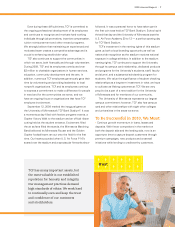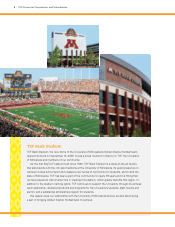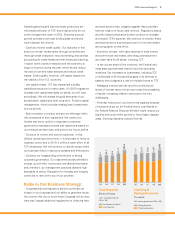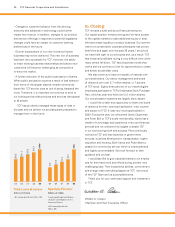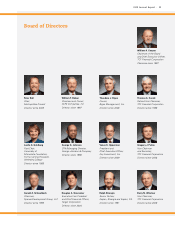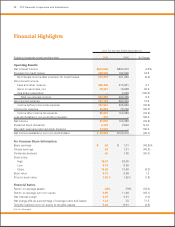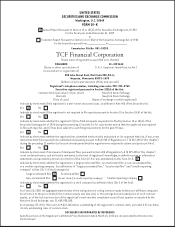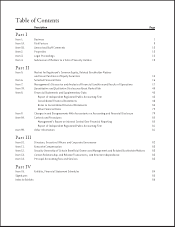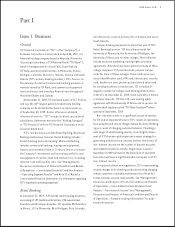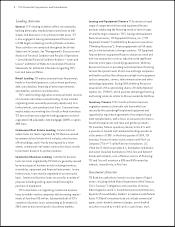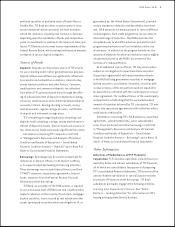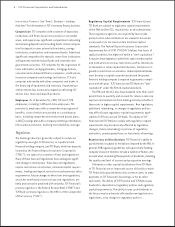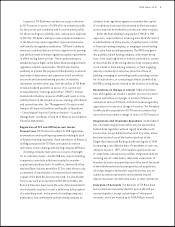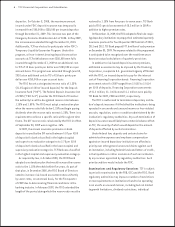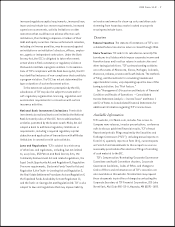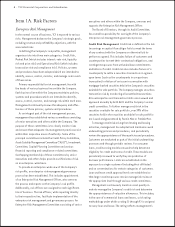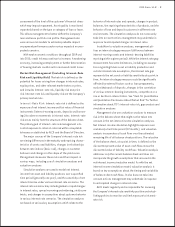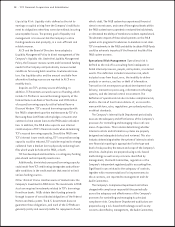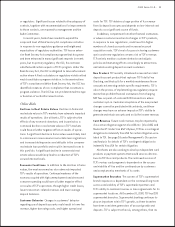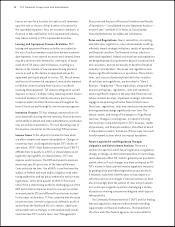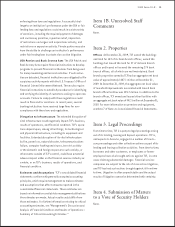TCF Bank 2009 Annual Report Download - page 19
Download and view the complete annual report
Please find page 19 of the 2009 TCF Bank annual report below. You can navigate through the pages in the report by either clicking on the pages listed below, or by using the keyword search tool below to find specific information within the annual report.
2009 Form 10-K : 3
preferred securities or preferred stock of Fannie Mae or
Freddie Mac. TCF Bank also does not participate in struc-
tured investment vehicles and does not have any bank-
owned life insurance. Liquidity may increase or decrease
depending upon the availability of funds and comparative
yields on investments in relation to the returns on loans and
leases. TCF Bank must also meet reserve requirements of the
Federal Reserve Board, which are imposed based on amounts
on deposit in various deposit categories.
Sources of Funds
Deposits are the primary source of TCF’s funds
for use in lending and for other general business purposes.
Deposit inows and outows are signicantly inuenced
by economic and competitive conditions, interest rates,
money market conditions and other factors. Consumer,
small business and commercial deposits are attracted
from within TCF’s primary market areas through the offer-
ing of a broad selection of deposit instruments including
consumer, small business and commercial demand deposit
accounts, interest-bearing checking accounts, money
market accounts, regular savings accounts, certicates
of deposit and retirement savings plans.
TCF’s marketing strategy emphasizes attracting core
deposits held in checking, savings, money market and cer-
ticate of deposit accounts. These accounts are a source of
low-interest cost funds and provide signicant fee income.
Information concerning TCF’s deposits is set forth
in “Management’s Discussion and Analysis of Financial
Condition and Results of Operations — Consolidated
Financial Condition Analysis — Deposits” and in Note 9 of
Notes to Consolidated Financial Statements.
Borrowings may be used to compensate for
reductions in deposit inows or net deposit outows,
or to support expanded lending and leasing activities.
These borrowings may include Federal Home Loan Bank
(“FHLB”) advances, repurchase agreements, federal
funds, advances from the Federal Reserve Discount
Window and other borrowings.
TCF Bank, as a member of the FHLB system, is required
to own a minimum level of FHLB stock and is authorized to
apply for advances on the security of such stock, mortgage-
backed securities, loans secured by real estate and other
assets (principally securities which are obligations of, or
guaranteed by, the United States Government), provided
certain standards related to creditworthiness have been
met. FHLB advances are made pursuant to several different
credit programs. Each credit program has its own interest
rates and range of maturities. The FHLB prescribes the
acceptable uses to which the advances pursuant to each
program may be made as well as limitations on the size
of advances. In addition to the program limitations, the
amounts of advances for which an institution may be eligible
are generally based on the FHLB’s assessment of the
institution’s creditworthiness.
As an additional source of funds, TCF may sell securities
subject to its obligation to repurchase these securities
(repurchase agreements) with major investment banks
or the FHLB utilizing government securities or mortgage-
backed securities as collateral. Generally, securities with
a value in excess of the amount borrowed are required to
be deposited as collateral with the counterparty to a repur-
chase agreement. The creditworthiness of the counterparty
is important in establishing that the overcollateralized
amount of securities delivered by TCF is protected. TCF only
enters into repurchase agreements with institutions with a
satisfactory credit prole.
Information concerning TCF’s FHLB advances, repurchase
agreements, subordinated notes, junior subordinated
notes (trust preferred) and other borrowings is set forth
in “Management’s Discussion and Analysis of Financial
Condition and Results of Operations — Consolidated
Financial Condition Analysis — Borrowings” and in Notes 10
and 11 of Notes to Consolidated Financial Statements.
Other Information
TCF’s business operations include those con-
ducted by direct and indirect subsidiaries of TCF Financial,
all of which are consolidated for purposes of preparing
TCF’s consolidated nancial statements. TCF does not utilize
unconsolidated subsidiaries or special purpose entities
to provide off-balance sheet borrowings. TCF Bank
subsidiaries principally engage in the following activities.
Leasing and Equipment Finance See “Item 1.
Business — Lending Activities” for information on TCF’s
leasing and equipment nance business.


